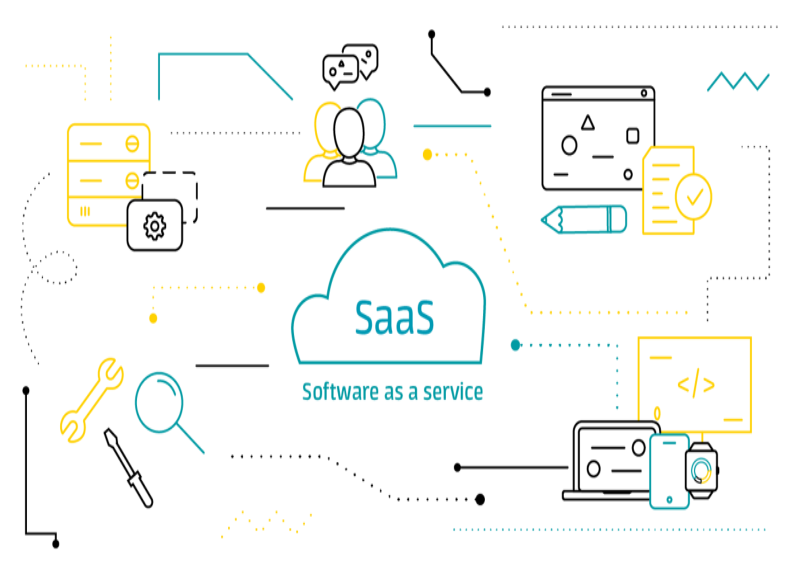What is program as a service?

Software as a service (SaaS) is a way of delivering applications as a service over the internet. Instead of installing and maintaining software, you can simply access it over the Internet, freeing you from the complexities of software and hardware management.
What is SaaS?
Software as a service (or SaaS) is a way of delivering applications over the Internet—as a service. Instead of installing and maintaining software, you simply access it via the Internet, freeing yourself from complex software and hardware management.
SaaS applications are sometimes called Web-based software, on-demand software, or hosted software. Whatever the name, SaaS applications run on a SaaS provider’s servers. The provider manages access to the application, including security, availability, and performance.
Salesforce has revolutionised CRM with our SaaS based product. Learn More:
SaaS Characteristics
A good way to understand the SaaS model is by thinking of a bank, which protects the privacy of each customer while providing service that is reliable and secure—on a massive scale. A bank’s customers all use the same financial systems and technology without worrying about anyone accessing their personal information without authorisation.
A “bank” meets the key characteristics of the SaaS model:
Multitenant Architecture
A multitenant architecture, in which all users and applications share a single, common infrastructure and code base that is centrally maintained. Because SaaS vendor clients are all on the same infrastructure and code base, vendors can innovate more quickly and save the valuable development time previously spent on maintaining numerous versions of outdated code.
Easy Customisation
The ability for each user to easily customise applications to fit their business processes without affecting the common infrastructure. Because of the way SaaS is architected, these customisations are unique to each company or user and are always preserved through upgrades. That means SaaS providers can make upgrades more often, with less customer risk and much lower adoption cost.
Better Access
Improved access to data from any networked device while making it easier to manage privileges, monitor data use, and ensure everyone sees the same information at the same time.
SaaS Harnesses the Consumer Web
Anyone familiar with Amazon.com or My Yahoo! will be familiar with the Web interface of typical SaaS applications. With the SaaS model, you can customise with point-and-click ease, making the weeks or months it takes to update traditional business software seem hopelessly old fashioned.
SaaS Trends
Organisations are now developing SaaS integration platforms (or SIPs) for building additional SaaS applications. The consulting firm Saugatuck Technology calls this the “third wave” in software adoption: when SaaS moves beyond standalone software functionality to become a platform for mission-critical applications.
SaaS is one of several cloud computing solutions for business IT issues. Other ‘as-a-Service’ options include:
- Infrastructure as a Service (IaaS) – the provider hosts hardware, software, storage and other infrastructure component
- Platform as a Service (PaaS)
- Everything as a service (XaaS) – which is essentially all the "aaS" tools neatly packaged together.
The payment model for these kinds of services is typically a per-seat, per-month charge based on usage – so a business only has to pay for what they need, reducing upfront costs.
SaaS v packaged software
In the past, businesses bought and relied on packaged software – from multi-application systems covering spreadsheets, databases and email to specialist packages for particular tasks like project management or business intelligence.
Packaged software – the drawbacks
To use sales and marketing as an example, a business may have used on-premises software for CRM.
- This software needed to be evaluated, bought, installed, kept secure, maintained and regularly upgraded on in-house systems by the internal IT department.
- Using packaged software placed a burden on the IT team which could turn into a bottleneck for projects.
- A business could end up needing to support a wide variety of systems side by side, but find it tricky to integrate them as they were coded and built differently.
- This approach also presented upfront costs for software and licences and potentially servers for the software to sit on.
- The costs of the CRM software and hardware might mean it is not affordable for small businesses. It could also be difficult to scale up quickly in response to growth or change.
The benefits of SaaS
Increased efficiency and cost effectiveness are the reasons many businesses give for turning to cloud-based SaaS solutions. The advantages include:
- Low setup and infrastructure costs
You just pay for what you need with no capital expenditure that needs to be depreciated on your balance sheet over time. - Accessible from anywhere
Just connect to the internet and you can work from wherever you need to be via desktop, laptop, tablet or mobile or other networked device. - Scalability
You can adapt your requirements to the number of people who need to use the system, the volume of data and the functionality required as your business grows. - Industry leading service level agreements (SLAS) for uptime and performance
So you have assurances that the software will be available to use when you need it – a difficult promise for in-house teams to make. - Automatic, frequent updates
Providers offer timely improvements thanks to their scale and because they receive feedback about what their customers need. This frees up your IT department for other more business-critical tasks. - Security at the highest level required by any customer
Because of the shared nature of the service, all users benefit from the security level that’s been set up for those with the highest need.
The future of SaaS
Cloud computing and SaaS have come a long way in a short time. Increased awareness and uptake has accelerated the growth of SaaS products and led to the rise of SaaS Integration Platforms (SIPs) such as Infrastructure as a Service (IaaS) and Platform as a Service (PaaS). Companies will continue to outsource non-core IT activities to specialist service providers who can do it better. The cloud approach can help companies develop end-to-end integrated solutions and allow them to concentrate on what they do best, leaving a wide range of hardware and software IT issues to service providers.
With companies adopting various "aaS" services, long-term relationships with service providers will grow – which in turn will lead to innovation as customers' growing needs are understood and provided for.
In the future, high-performance computing will help with a wide range of business uses, such as analysing large volumes of customer data and monitoring application logs. SaaS may be one day be able to help address critical challenges for business such as predicting which customers will churn or which cross-selling practices work best for your business.
With the need for high-volume data, software performance and backup increasingly daily, it’s easy to see why so many businesses are choosing to outsource to cloud-based providers. If you’re considering a move to a SaaS platform, find out what Salesforce has to offer for businesses of all sizes.
